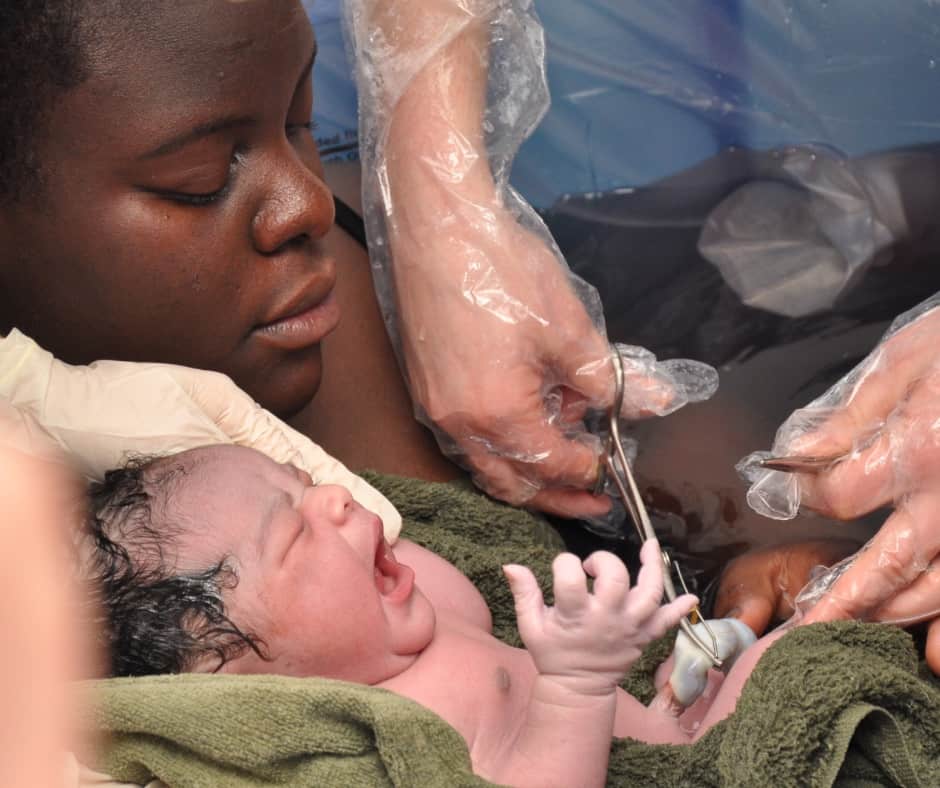Factsheet: Breech Presentation
By Abbie Tomson RM BSc MSc
Midwife, All4Birth Co-Lead
Summary
A breech presentation occurs when the baby is ‘bum’ down rather than head down. It becomes less common, the further into pregnancy you get. There are some situations where you may be more likely to have a breech presentation, baby. Most babies will turn prior to birth, and as this factsheet explains, there is much debate around breech birth!
What is a breech presentation?
A breech presentation occurs in 3-4% of term births and is more common in preterm babies and women having their first baby 1. Usually, a breech baby is first recognised by a community midwife at a regular antenatal appointment, if this is after 36 weeks’ gestation, the midwife will recommend referral for a ‘presentation’ ultrasound to determine whether the baby is breech and in which breech position.
Risk Factors for Breech Presentation2
- Advanced maternal age
- Nulliparity
- Maternal hypothyroidism
- Gestational diabetes
- Placenta praevia
- Premature rupture of membranes
- Oligohydramnios
- Congenital anomaly
- Female sex of the infant
- Birth weight below 10th centile
Types of Breech Presentation3
Frank breech- extended breech. Baby’s legs are up next to its abdomen, knees straight and feet next to its ears. This is the most common. 65-70% of breech babies are in this position.
Complete breech or flexed breech- when the baby appears to be sitting cross-legged with legs bent at the hips and knees.
A footling breech- one or both of the baby’s feet are coming first vs their pelvis.
There are biomechanical techniques and positions that can help encourage a baby to turn, but it is important to discuss them with your care provider prior to undertaking them. Additionally, it may be that your midwife has been trained in these techniques. Please check out the resource section for further information.
Birth Options
If your baby is presenting in the breech presentation at term, you will be offered an external cephalic version (ECV) unless there are absolute contraindications. You will also be given the opportunity to discuss vaginal breech birth or a planned caesarean section 1. However, UK data has reported that breech presentation is not diagnosed until labour in around 25% of women 4.
General principles: 1
- Induction of labour is not usually recommended
- RCOG report that evidence is lacking in EFM, but its continuous use may lead to improved neonatal outcomes. EFM was used in the PREMODA study, where excellent results of planned vaginal breech birth are documented 5
- Overall RCOG determined that the essential components of planned vaginal breech birth are appropriate case selection, management according to a protocol and the availability of skilled attendants
The Term Breech Trial 6
Following the publication of the Term Breech Trial 6 many doctors and midwives have lost their skills in vaginal breech births, or many have never experienced vaginal birth, and therefore can lack the skills to do so safely. This was due to a large reduction in planned vaginal breech births following the publication as overnight it changed the advice provided to women regarding vaginal breech. The Term Breech Trial 6 was a multi-centre randomised controlled trial, across 26 countries. It concluded that planned caesarean birth was safer for term babies, and reduced the risk of perinatal mortality and morbidity compared to planned vaginal breech birth. Following publication, 92 of the centres changed guidelines to planned caesarean birth for breech presentation. However, the trial has faced criticism. Although it is a randomised controlled trial and therefore considered the gold standard, it was across so many countries and centres with variation in practice, skills, resources, and skills in birth that it’s difficult to draw a direct conclusion due to lack of control of the variables. Additionally, case selection and intrapartum management were the main critiques. This included 31% of cases having no ultrasound to confirm whether the cases were appropriate for planned vaginal breech birth, growth-restricted babies were included and a few women were randomised in violation of the protocol and then included in the intention to treat analysis ref. Furthermore, although the initial outcome for the baby was improved with a planned caesarean birth compared to vaginal birth, by two years there was no difference between the two birth outcomes 7.
Although not a lot of evidence exists, it appears The attendance of a skilled and experienced professional is the only factor associated with a reduction in perinatal mortality in previous, high-quality research. The PREMODA study 5 aimed to examine the effect of more strict selection and management of vaginal breech birth, with 2526 planned vaginal breech deliveries compared with 5579 planned caesarean births, with a senior obstetrician present at 92.3% of all vaginal deliveries. Vaginal breech births do happen, as women continue to make decisions regarding their care, and in some cases, because we did not know the position of the baby until the latter stages of labour. Midwives and doctors continue to practice these skills through emergency skills, usually annually, to ensure they have practical skills for when these situations arise.
A retrospective cohort study was undertaken 8, looking back on women who presented for singleton breech birth at a centre in Frankfurt between January 2004- June 2011. Of 269 successful vaginal births, 229 were in the upright position compared to 40 in the dorsal position. Upright births were associated with significantly fewer delivery manoeuvres and neonatal birth injuries, with shorter second stages of labour.
Statistics of Note
When planning for a breech baby, the chance of perinatal mortality is approx. 0.5/1000 with a caesarean birth after 39 weeks 1 and approximately 2/1000 with a planned vaginal breech birth 1. This compares to approximately 1/1000 with planned head-down births 1
Planned caesarean birth for breech presentation at term carries a small increase in immediate complications for the mother compared to planned vaginal birth (infection/Thrombosis/pain/injury to bladder/bowel/bleeding) 1. Caesarean birth in general increases the chance of complications in future pregnancies including scar dehiscence, increased complications of an elective repeat CS and the chance of abnormally invasive placenta 1.
Planned vaginal birth increases the risk of low Apgar scores and serious short-term complications 1, but no evidence has shown an increase in the risk of long-term morbidity 1.
A higher risk planned vaginal breech birth is expected where there are independent indications for caesarean birth and in the following circumstances: 1
- The hyperextended neck on ultrasound
- High estimated fetal weight
- Low estimated weight
- Footling presentation
- Evidence of antenatal fetal compromise
Optibreech 9
The OptiBreech project is currently ongoing by Dr Shawn Walker which is exploring the feasibility of evaluating a new care pathway for women with a breech pregnancy. To see if your local hospital, or one near you is part of the trial check out the OptiBreech site listed in the resources. It is a non-randomised trial, observing outcomes on a large group of women with a breech-presenting baby who are planning Optibreech care or has a vaginal breech birth at the end of pregnancy. Care starts when the baby has been diagnosed as breech after 36 weeks and follows through to birth, regardless of whether you plan to have an ECV, vaginal birth or planned caesarean. Those who choose a vaginal breech birth will have care provided by a proficient team, all of which have had enhanced training in physiological breech birth.
Postnatal Care
Your postnatal care should not differ greatly based on the baby being born in the breech position. However, you may feel that you want to talk through your birth. (Whichever method you decide), and most trusts offer a ‘birth afterthoughts’ clinic now where you can discuss your brief. Alternatively, following the birth, your midwife and/or the obstetric team can provide a debrief to explain what happened and why, particularly if you have any questions or queries. However, if you are in the UK and your baby was breech after 36 weeks gestation, the baby will automatically be referred for a hip scan at 6 weeks to rule out ‘congenital hip dysplasia’.
Practical Ideas and Links to Online Communities
Understand your body, understand your rights, and options and seek out second opinions if you feel it is challenging. The resources below are not exhaustive, and if you feel there is something we should include that isn’t there currently, please let us know! We are keen to make this an inclusive and useful resource section for further information.
Links to other resources
 Articles
Articles
Continuous support for women during childbirth Cochrane Review 2017
Relaxation techniques for pain management on labour Cochrane Review 2018
 Guidelines
Guidelines
 Books
Books
AIMS: Breech birth: What are my options?
 Additional Online Resources
Additional Online Resources
The Obs Pod ‘Episode 31: Bottom Down’
Optimal Birth- Breech Information
References
[1] Royal College of Obstetricians and Gynaecologists (2017) Management of Breech Presentation
[2] Toijonen, A. E., Heinonen, S. T., Gissler, M. V. M., & Macharey, G. (2020). A comparison of risk factors for breech presentation in preterm and term labor: a nationwide, population-based case-control study. Archives of gynecology and obstetrics, 301(2), 393–403. https://doi.org/10.1007/s00404-019-05385-5
[3] National Library of Medicine (2022) Breech Presentation
[4] Hemelaar, J., Lim, L. N., & Impey, L. W. (2015). The Impact of an ECV Service is Limited by Antenatal Breech Detection: A Retrospective Cohort Study. Birth (Berkeley, Calif.), 42(2), 165–172. https://doi.org/10.1111/birt.12162
[5] Goffinet, F., Carayol, M., Foidart, J. M., Alexander, S., Uzan, S., Subtil, D., Bréart, G., & PREMODA Study Group (2006). Is planned vaginal delivery for breech presentation at term still an option? Results of an observational prospective survey in France and Belgium. American journal of obstetrics and gynecology, 194(4), 1002–1011. https://doi.org/10.1016/j.ajog.2005.10.817
[6] Hannah, M. E., Hannah, W. J., Hewson, S. A., Hodnett, E. D., Saigal, S., & Willan, A. R. (2000). Planned caesarean section versus planned vaginal birth for breech presentation at term: a randomised multicentre trial. Term Breech Trial Collaborative Group. Lancet (London, England), 356(9239), 1375–1383. https://doi.org/10.1016/s0140-6736(00)02840-3
[7] Hannah, M. E., Whyte, H., Hannah, W. J., Hewson, S., Amankwah, K., Cheng, M., Gafni, A., Guselle, P., Helewa, M., Hodnett, E. D., Hutton, E., Kung, R., McKay, D., Ross, S., Saigal, S., Willan, A., & Term Breech Trial Collaborative Group (2004). Maternal outcomes at 2 years after planned cesarean section versus planned vaginal birth for breech presentation at term: the international randomized Term Breech Trial. American journal of obstetrics and gynecology, 191(3), 917–927. https://doi.org/10.1016/j.ajog.2004.08.004
[8] Louwen, F., Daviss, B. A., Johnson, K. C., & Reitter, A. (2017). Does breech delivery in an upright position instead of on the back improve outcomes and avoid cesareans?. International journal of gynaecology and obstetrics: the official organ of the International Federation of Gynaecology and Obstetrics, 136(2), 151–161. https://doi.org/10.1002/ijgo.12033
[9] OptiBreech Care Trial: www.optibreech.uk















